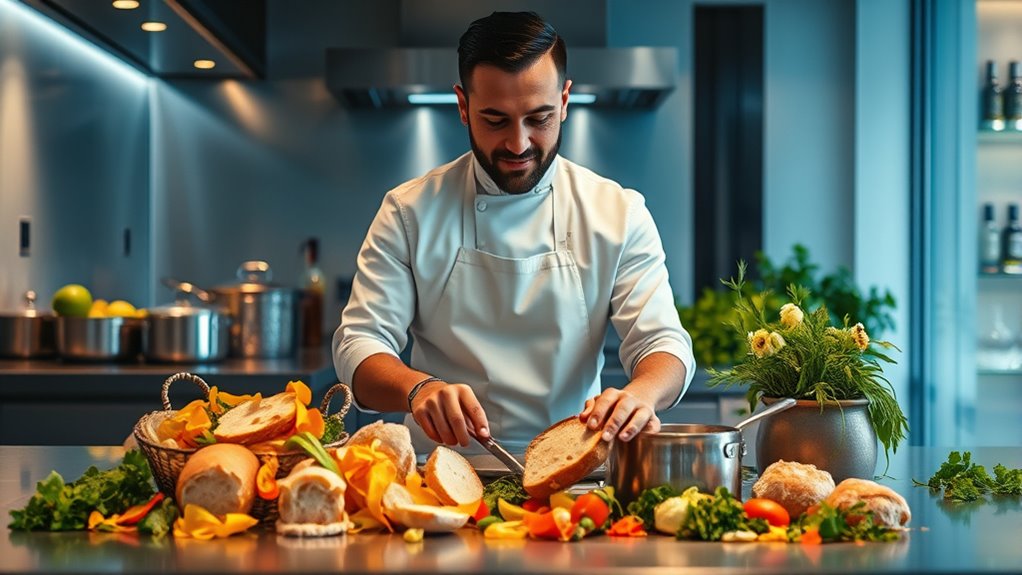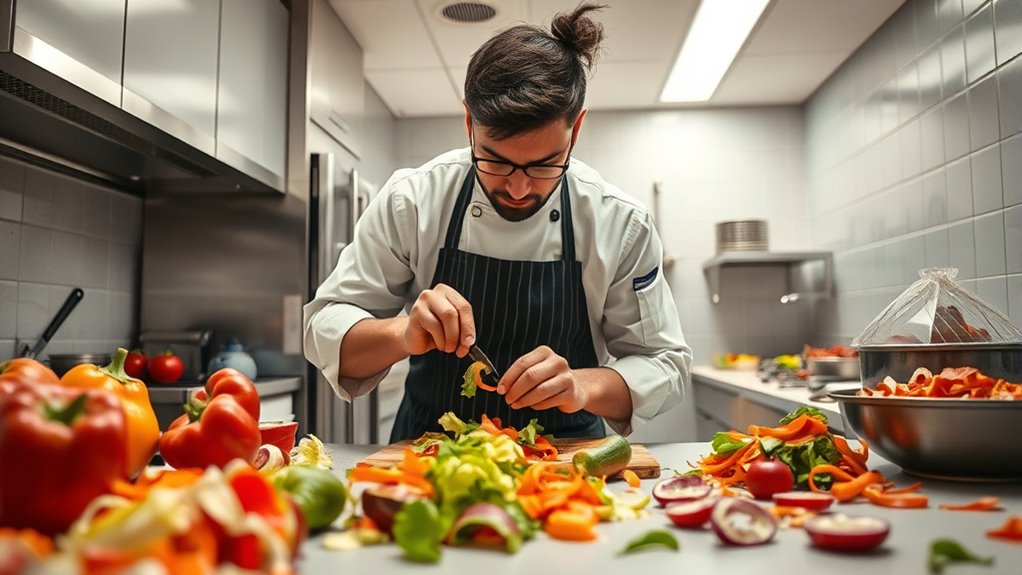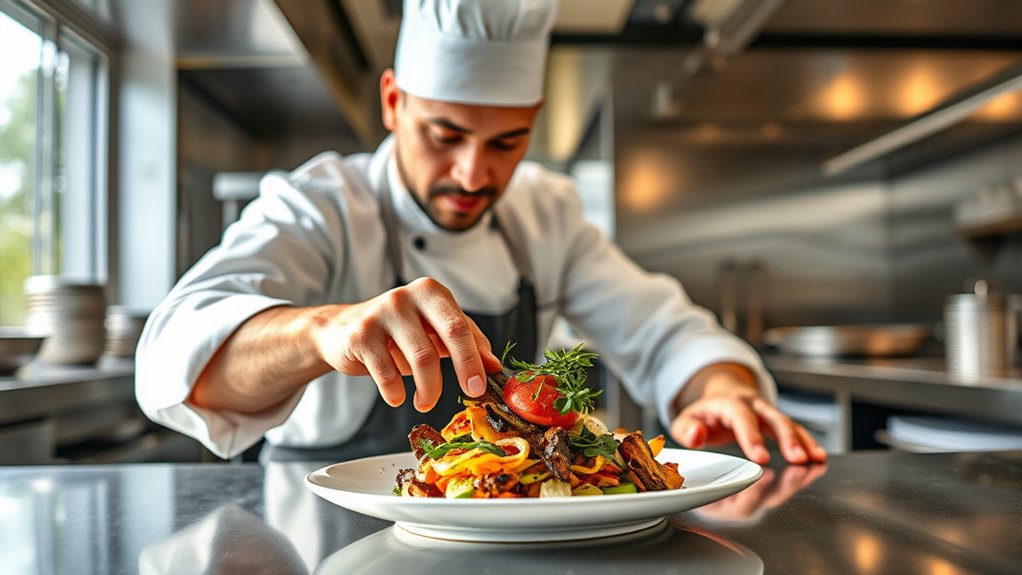Chefs are transforming kitchen scraps and leftovers into Michelin-starred dishes, turning food waste into culinary masterpieces. They creatively repurpose ingredients like vegetable trimmings, stale bread, and overripe fruits into gourmet bites, showing sustainability can elevate fine dining. By using innovative techniques such as fermentation and slow-cooking, these chefs demonstrate how waste can become a valuable ingredient. If you keep exploring, you’ll discover the inspiring ways top kitchens turn garbage into gold.
Key Takeaways
- Chefs creatively repurpose food scraps like vegetable stems and peels into gourmet broths and sauces.
- Innovative techniques such as fermenting and slow-cooking transform leftovers into high-end dishes.
- Using stale bread and trims, chefs craft upscale items like croutons, bread pudding, or terrines.
- Transparency about waste reduction efforts enhances guest appreciation of sustainable, five-star culinary practices.
- Community programs and local sourcing support waste minimization while showcasing gourmet dishes made from surplus ingredients.
The Hidden Scale of Food Waste in Fine Dining

Although the visible leftovers and plate waste are often obvious, the true extent of food waste in fine dining remains largely hidden. You might see discarded food at the end of a shift, but much more waste occurs behind the scenes. In gourmet kitchens, trimming, overproduction, and ingredient spoilage happen quietly, often unnoticed. Chefs and staff trim excess fat, peelings, and imperfect produce that don’t make it to the plate, yet these scraps are rarely counted as waste. Complex menus and strict presentation standards lead to frequent overstocking and unused ingredients. As a result, a significant portion of food waste stays out of sight, quietly contributing to economic loss and environmental damage. This hidden waste underscores a major challenge in achieving true sustainability in fine dining. Additionally, eye patch benefits, such as reducing puffiness and providing hydration, highlight the importance of addressing minor issues promptly—similar to how managing small scraps can reduce overall waste in a kitchen. Recognizing these waste management strategies can help restaurants adopt more sustainable practices and reduce their environmental footprint. Furthermore, understanding food spoilage patterns can assist chefs in optimizing inventory and minimizing unnecessary disposal, especially as emerging AI-driven analytics tools become more prevalent in managing kitchen supplies. Incorporating mental focus techniques like meditation can enhance concentration during busy kitchen hours, leading to better waste control and resourcefulness.
Causes Behind Excessive Trimming and Overproduction

Excessive trimming and overproduction in fine dining stem from a combination of high standards and menu complexity. You aim for perfect presentation and top-quality ingredients, which often leads to trimming away more than necessary to meet aesthetic expectations. Complex menus require a wide variety of ingredients, increasing the risk of overbuying and unused supplies. When chefs prepare in bulk or overestimate customer demand, excess food accumulates, resulting in waste. Additionally, strict portion control and fear of running out can cause overproduction, leaving leftovers on plates or unused ingredients in storage. Staff practices, such as overly cautious trimming or poor Inventory management, practices, further contribute. These factors combine to create a cycle of unnecessary trimming and surplus, fueling the overall food waste problem. When optimized inventory systems are implemented, they can help reduce overproduction and minimize waste. Incorporating proper storage techniques and regular inventory audits can also help prevent spoilage and overstocking, further reducing waste.
The Chef’s Role in Minimizing Kitchen Waste

As a chef, you control the kitchen’s workflow and can identify areas where waste occurs. By creatively reusing ingredients, you turn trims and leftovers into new dishes, cutting down waste. Proper staff training guarantees everyone understands how to minimize waste and work efficiently. Additionally, fostering a culture of appreciation for food conservation encourages team members to stay motivated and committed to waste reduction practices. Implementing food waste tracking tools can further help monitor and improve waste management strategies. Understanding the contrast ratio of kitchen appliances can help optimize lighting and display areas, reducing unnecessary energy consumption.
Kitchen Workflow Optimization
Chefs play a pivotal role in minimizing kitchen waste by designing efficient workflows that reduce unnecessary steps and optimize ingredient usage. You can streamline prep tasks by organizing stations logically, ensuring tools and ingredients are within easy reach. Implement batch prep techniques to minimize overproduction and ensure ingredients are used before spoilage. Use precise inventory management, tracking expiration dates and adjusting orders accordingly to prevent excess. Standardize portion sizes to avoid leftovers and over-serving. Regularly review kitchen processes to identify waste hotspots and adjust workflows accordingly. Incorporate technology, like digital ordering systems, to better forecast demand and plan accordingly. By creating a smooth, mindful workflow, you reduce waste at every stage, saving resources and supporting sustainability efforts. Additionally, understanding Self Watering Plant Pots can inspire sustainable practices in kitchen garden setups or staff plant care initiatives. Recognizing the importance of emergency preparedness can also help kitchens develop contingency plans for unexpected disruptions, ensuring continuity and safety.
Creative Ingredient Reuse
Creative ingredient reuse is an essential strategy for chefs aiming to reduce kitchen waste and promote sustainability. By rethinking how ingredients are utilized, you transform what would be discarded into innovative, high-quality dishes. This approach not only minimizes waste but also sparks culinary creativity and ethical responsibility. Applying food waste diversion techniques can further enhance your sustainability practices and reduce environmental impact. Understanding waste management principles can help optimize your efforts in minimizing excess and ensuring that no usable ingredient goes to waste. Incorporating sustainable practices such as composting scraps and choosing eco-friendly packaging can further elevate your kitchen’s environmental responsibility. Turn vegetable trimmings into flavorful stocks or sauces that elevate your dishes. Use leftover bread for croutons, bread pudding, or breadcrumbs, adding texture and depth. Repurpose overripe fruits into jams, compotes, or desserts that delight diners. Transform unused vegetable stems and leaves into pesto, pesto-like spreads, or garnishes. Experimenting with ingredient repurposing can inspire innovation and reduce your kitchen’s ecological footprint. Your proactive reuse can evoke emotion, inspire diners, and demonstrate that waste isn’t the end—it’s an opportunity for culinary innovation.
Staff Training Initiatives
Effective staff training is key to turning culinary creativity into sustainable practice. When you focus on educating your team about waste reduction, you empower them to make smarter decisions during prep and service. Teaching proper trimming techniques, storage methods, and portion control helps minimize unnecessary discard. Incorporate training sessions that highlight the importance of resourcefulness, encouraging staff to reuse trimmings and identify opportunities for repurposing leftovers. Make waste reduction part of your kitchen culture by setting clear goals and monitoring progress. Regular feedback and hands-on demonstrations ensure everyone understands their role in waste prevention. When your team is well-trained, they become proactive stewards of sustainability, transforming waste management from an afterthought into a core element of your culinary excellence. Incorporating waste reduction techniques and emphasizing the importance of resourcefulness can further enhance your kitchen’s overall efficiency and environmental impact. Additionally, integrating Affiliate disclosures into training can ensure transparency with your team regarding the use of affiliate links in sourcing sustainable products. Staying informed about content quality and topical authority can further reinforce best practices and motivate continuous improvement within your team.
Innovative Techniques for Repurposing Leftovers

Innovative techniques for repurposing leftovers are transforming how restaurants minimize waste and maximize value. You can turn scraps into gourmet creations, reducing environmental impact and impressing diners. Chefs now use methods like blending roasted vegetable trimmings into flavorful soups, fermenting bread crusts into crispy croutons, or transforming leftover meats into rich terrines. These approaches not only save ingredients but tell a story of resourcefulness and sustainability. Incorporating wood stove decor ideas can even inspire a cozy, eco-conscious ambiance in food presentation or restaurant design.
Transforming leftovers into gourmet dishes reduces waste and showcases culinary ingenuity and sustainability.
These techniques turn what was once waste into a celebration of culinary creativity and responsibility.
Community Initiatives Turning Waste Into Gourmet Goodness

Community initiatives are transforming food waste into gourmet experiences by connecting restaurants with local charities and food redistribution programs. You can see how these efforts turn surplus ingredients and unsold dishes into high-quality meals for those in need. Chefs and organizations collaborate to donate edible leftovers, reducing waste while supporting vulnerable populations. Some restaurants host community kitchens where surplus food becomes gourmet fare, showcasing creativity and social responsibility. Short supply chains and local sourcing further minimize spoilage and ecological impact. These initiatives foster a sense of shared purpose, encouraging diners to see waste reduction as a community effort. By participating in or supporting these programs, you help promote sustainability while making gourmet food accessible to all, proving that waste can indeed become a culinary treasure.
How Transparency and Customer Engagement Drive Change

Transparency and active customer engagement are essential tools for driving meaningful change in restaurant food waste practices. When you’re open about your efforts, it builds trust and encourages diners to participate. By sharing stories of how leftovers become gourmet dishes or how waste is minimized, you inspire pride and responsibility. Engaging customers through feedback, educational campaigns, or menu options fosters a sense of shared purpose.
Consider how these actions impact you:
- You feel part of a movement toward sustainability, making your dining experience more meaningful.
- You’re empowered to make responsible choices, like ordering smaller portions or trying surplus-based specials.
- You develop loyalty to restaurants that prioritize honesty and social responsibility.
- Your support helps push the industry toward more eco-friendly, waste-conscious practices.
Transforming Waste Into Michelin-Star Creations

Restaurants are turning waste into high-end culinary experiences by reimagining what’s possible with leftover ingredients and trimmings. You can see chefs creatively repurpose vegetable scraps, meat trimmings, and surplus produce into stunning dishes that impress diners and reduce waste. For example, some Michelin-starred chefs use vegetable peels and stems to make flavorful broths or pickled condiments, elevating what was once discarded. Others transform leftover bread into croutons or bread pudding, turning stale items into gourmet treats. By embracing techniques like fermentation, slow-cooking, and clever plating, you turn waste into a statement of innovation. This approach not only minimizes environmental impact but also highlights the chef’s skill in creating sophisticated flavors from unlikely sources. It’s a bold step toward sustainable, five-star dining.
Frequently Asked Questions
How Do Chefs Decide Which Food Scraps to Reuse Creatively?
You decide which food scraps to reuse creatively by evaluating their quality, flavor potential, and safety. You look for trimmings, peels, or leftovers that can be transformed into new dishes or ingredients. You consider how well they complement your menu, ensuring they maintain your restaurant’s standards. With your culinary skill, you turn these scraps into innovative, delicious elements, reducing waste and showcasing your creativity and sustainability commitment.
What Training Helps Staff Reduce Waste During Food Prep?
You should undergo extensive staff training focused on proper food handling, trimming, and storage techniques. This training teaches you to identify edible scraps, optimize ingredient use, and avoid overproduction. You’ll learn to follow standardized portioning, monitor inventory closely, and implement waste-reducing practices consistently. Regular workshops and hands-on demos help reinforce these skills, empowering you to minimize waste during food prep and contribute to your restaurant’s sustainability goals.
How Do Restaurants Measure the Success of Waste Reduction Initiatives?
Think of waste reduction initiatives like a ship’s compass guiding you. You measure success through key metrics such as waste audits, tracking leftover food, and monitoring ingredient usage patterns. Customer feedback, portion control, and financial savings also serve as navigational tools. Regularly reviewing these indicators helps you steer your restaurant toward sustainability, ensuring your efforts are on course and making a tangible difference in reducing food waste.
Are There Specific Tools That Help Track Kitchen Waste More Effectively?
You can use kitchen waste tracking tools like digital waste logs, inventory management software, and waste audit apps to monitor waste more effectively. These tools help you identify waste hotspots, track patterns, and measure the impact of your initiatives. By integrating real-time data, you gain better control over ingredient use, reduce overproduction, and make informed decisions, ultimately minimizing waste and improving overall kitchen efficiency.
How Can Customer Feedback Influence Waste Reduction Practices?
Customer feedback acts like a compass, guiding you toward better waste practices. When diners express concern about portion sizes or suggest eco-friendly options, you can adjust menus and serving styles accordingly. By listening actively, you identify waste hotspots and implement targeted solutions. Engaging with customers also builds loyalty, showing you’re committed to sustainability. Their insights help refine waste reduction efforts, making your restaurant more efficient and environmentally responsible.
Conclusion
By embracing sustainable practices, you can help reduce the staggering 931 million tons of food wasted globally each year. Imagine turning what’s often discarded into five-star dishes—your choices in the kitchen make a difference. As chefs innovate and communities get involved, waste transforms into gourmet experiences. Together, we can challenge the status quo, proving that even waste can be a source of culinary excellence and environmental impact.







